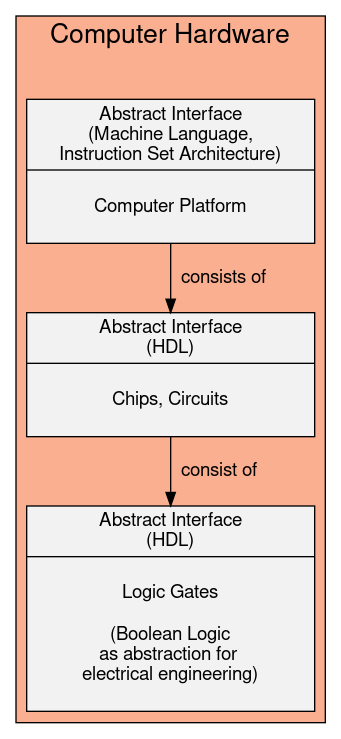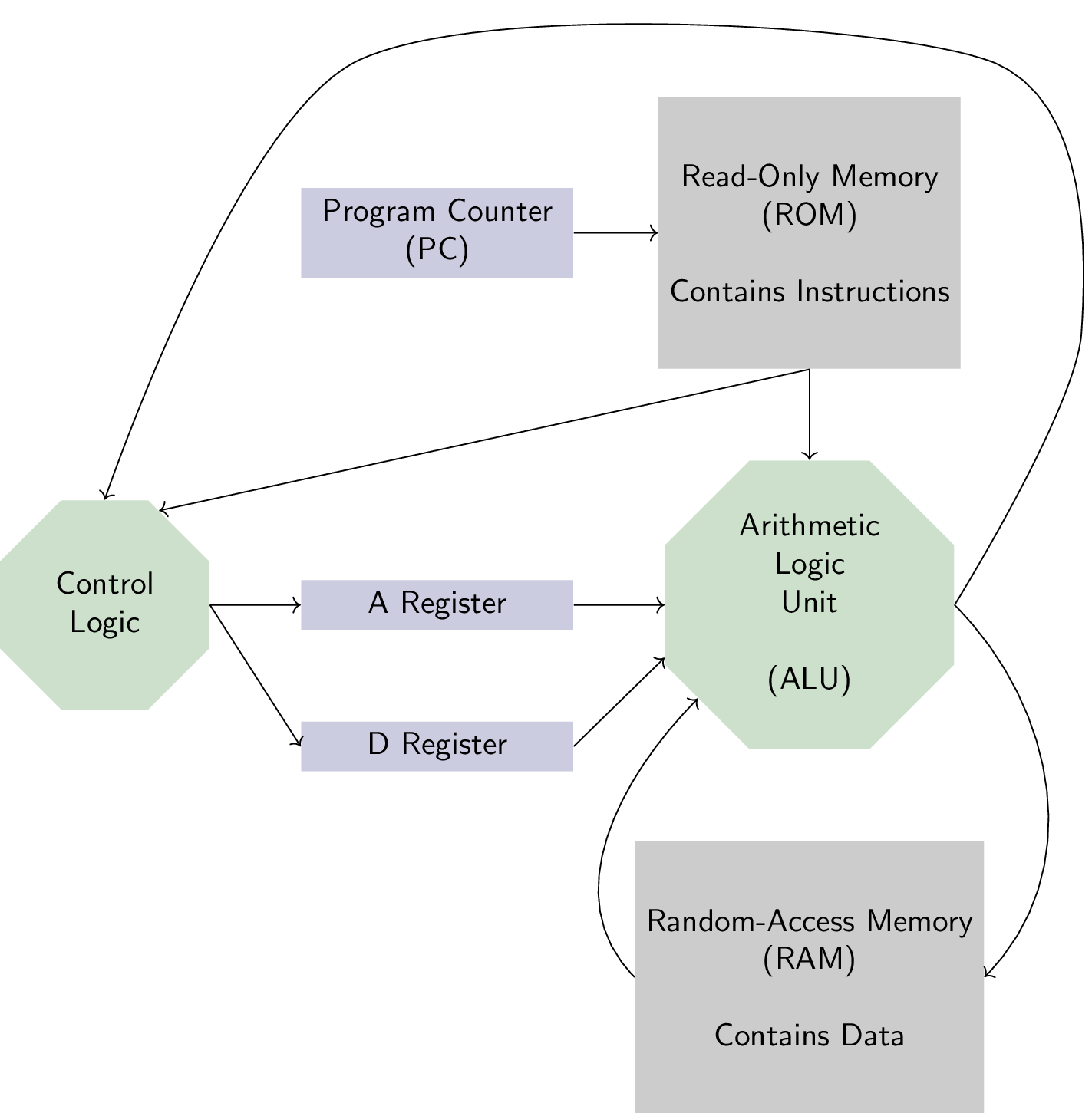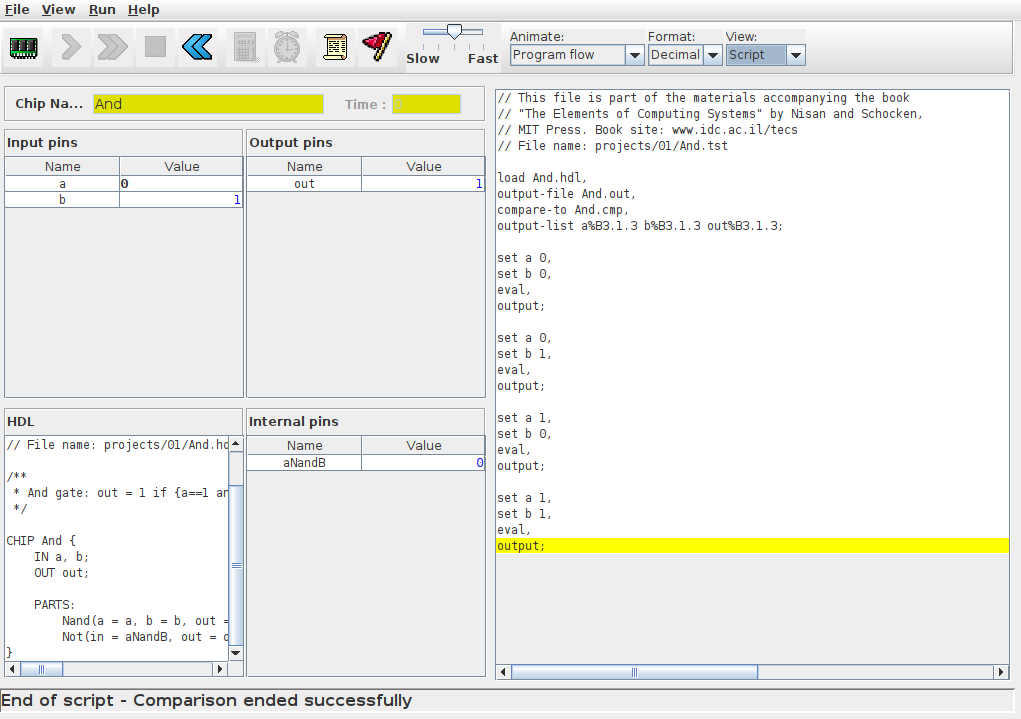Nand2Tetris
(Usage hints for this presentation)
IT Systems, Summer Term 2026
Dr. Matthes Elstermann (License Information)
1. Introduction
Video by co-creator of Nand2Tetris
1.1. Today’s Core Question
- How to start with Nand2Tetris?
1.2. Learning Objectives
- Build simple chips with HDL
- Simulate chips in Hardware Simulator
1.3. Retrieval Practice
- What do you remember about Part 1 of IT Systems?
- Other parts?
1.4. Recall: Goal of Part 1
Recall: Build general-purpose, programmable computer; here, the Hack platform
![Computer hardware with layers of abstraction]()
- Programmable in machine language
- Built from chips and gates specified in hardware description
language (HDL)
- (Gates are “simple” chips)
- Nand2Tetris with sequence of projects
Agenda
2. Preview
2.1. Hack Machine Language
Hack CPU executes instructions in machine language
Each Hack instruction consists of 16 bits
- Consider increment of variable:
i = i + 1 - Translated into two Hack instructions
0000000000010000(A-instruction, starts with 0, binary number for 16)- Human-readable assembly language instruction:
@16 - Used here to specify memory (RAM) location for value of
variable
i
- Human-readable assembly language instruction:
1111110111001000(C-instruction, starts with 1, encodes operation)- Human-readable assembly language instruction:
M=M+1 - 6 red bits specify operation (compute
M+1), 3 blue bits specify where to store the result (inM, the memory location for variablei)
- Human-readable assembly language instruction:
- Consider increment of variable:
Modern processors behave similarly
- Later:
Fetch-Decode-Execute Cycle
- Fetch next instruction from memory, decode bits to determine operation and operands, execute
- Von Neumann architecture (von Neumann 1945)
- Later:
Fetch-Decode-Execute Cycle
2.2. Preview: Hack Computer Architecture
3. Projects of Nand2Tetris
3.1. What to Expect in a Project
Projects focus on successively more complex chips
From simple logic gates to entire computer
Digital/binary devices with bit as basic unit of information
- Bit = Logical state with two values: true/false or 1/0
- Data and instructions to be represented as sequences of bits
Chips come with specifications/interfaces (and tests)
- What to do. Abstraction!
Results/implementations for each project are building blocks for subsequent ones
- Abstraction and modularity!
You work on projects individually
- Without immediate impact on grading, but lasting impact on brains (and, thus, on exam results)
- (Solutions can be found on the web)
3.2. What to Expect in Project 1
Project 1
Given:
Nand(x, y),falsex y Nand(x, y) 0 0 1 0 1 1 1 0 1 1 1 0 Nandis a binary Boolean function- Specified by truth table to right
0representsfalse,1representstrue
Learn about Boolean logic
Implement sequence of chips (from specifications)
Not(x)Notflips its argument:true = Not(false),false = Not(true)- Implementation:
Not(x)=Nand(x, x)
AndTrueif and only if all arguments are true; revisited subsequently
Xor,Or,Mux, and several more…
4. And Gate
4.1. Specification of And Gate
Three files for binary function
And(a, b)- HDL file with interface and specification,
And.hdl
// This file is part of www.nand2tetris.org // and the book "The Elements of Computing Systems" // by Nisan and Schocken, MIT Press. // File name: projects/01/And.hdl /** * And gate: * out = 1 if (a == 1 and b == 1) * 0 otherwise */ CHIP And { IN a, b; OUT out; PARTS: // Put your code here: }File
And.cmpa b out 0 0 0 0 1 0 1 0 0 1 1 1 - Test cases (here, truth table)
File
And.tst- Test file for hardware simulator
- To check implementation against test cases
- HDL file with interface and specification,
4.2. Implementation of And Gate (1/3)
- What an
Andgate should doSpecification:
out == 1if and only ifa == b == 1- Interface in HDL skeleton:
And.hdl
CHIP And {
IN a, b;
OUT out;
PARTS:
// Put your code here:
}
4.3. Implementation of And Gate (2/3)
- Idea to implement
AndgateGate logic:
And(a, b) = Not(Nand(a, b))- Interface in HDL skeleton:
And.hdl
CHIP And {
IN a, b;
OUT out;
PARTS:
// Put your code here:
}
4.4. Implementation of And Gate (3/3)
- Implementation of
AndgateGate logic:
And(a, b) = Not(Nand(a, b))- Completed HDL file:
And.hdl
CHIP And {
IN a, b;
OUT out;
PARTS:
Nand(a = a, b = b, out = aNandB);
Not(in = aNandB, out = out);
}
5. Nand2Tetris Resources
5.1. Nand To Tetris Software
- Download Java software: https://www.nand2tetris.org/software
- (Java runtime needed. Install first.)
- ZIP archive, contains tools and project files
- I had to do this in the
toolssubdirectory:chmod u+x *.sh
- I had to do this in the
- We start with the Hardware Simulator
- (Later on, we also use the CPU Emulator)
- Nowadays, the Nand2Tetris team recommends an online IDE:
https://nand2tetris.github.io/web-ide/chip/
- Try above Java variant as exercise in digital sovereignty
5.2. Hardware Simulator
Previous
Andimplementation in Hardware Simulator- Major window parts
- HDL file in lower left, test script on right
- Values of “Input pins” can be entered, resulting “Output pins” and “Internal pins” can be computed
- Note message area at bottom. If not shown, resize window!
- Major window parts
5.3. Textbook for Nand2Tetris
- (Nisan and Schocken 2005) The Elements of Computing Systems
- Book chapters are available online: https://www.nand2tetris.org/course
- Hyperlinked from “reading person icons”
- We use Chapters/Projects 1, 2, 4, 5
- Book chapters are available online: https://www.nand2tetris.org/course
- Download chapters now, start to read and work on Project 1
- Note “Tips” and “Steps” at end of Chapter 1
6. Conclusions
6.1. A Related Story, 2021
- From Nand to Zero-Day Exploit
- Google Project Zero
on attack software targeting iPhones
- Discussion with hyperlink to https://www.nand2tetris.org/!
- Summary
- NSO Group used logic operations (And, Or, Xor, Xnor; functionally complete) of an image format (JBIG2, mostly outdated) to hijack iPhones
- 70,000 segment commands to define computer architecture with registers and 64-bit adder
- Quote
- “The bootstrapping operations for the sandbox escape exploit are written to run on this logic circuit and the whole thing runs in this weird, emulated environment created out of a single decompression pass through a JBIG2 stream. It’s pretty incredible, and at the same time, pretty terrifying.”
- Quotes regarding
working at Project Zero
- “learn about coding and how computers work”
- “learning the fundamentals of programming, operating systems, and machine architecture is a great starting point”
- Google Project Zero
on attack software targeting iPhones
6.2. Summary
- Nand2Tetris guides you to build a computer
- Based on abstraction and modularity
- Weekly projects, with guidance from us
6.3. Q&A
Bibliography
License Information
Source files are available on GitLab (check out embedded submodules) under free licenses. Icons of custom controls are by @fontawesome, released under CC BY 4.0.
Except where otherwise noted, the work “Nand2Tetris”, © 2024-2025 Jens Lechtenbörger, is published under the Creative Commons license CC BY-SA 4.0.






